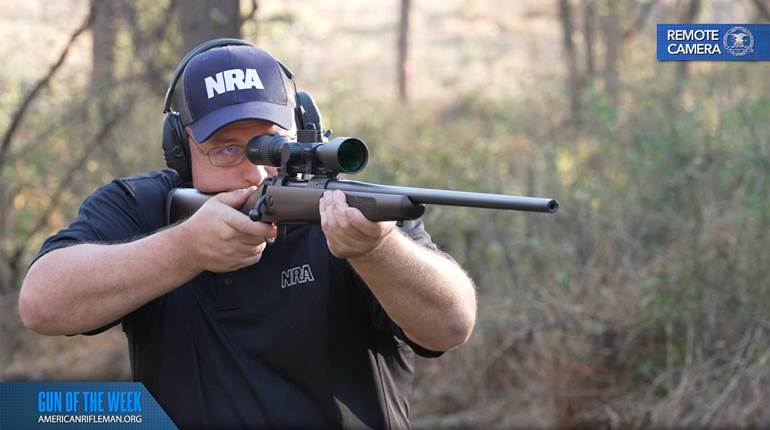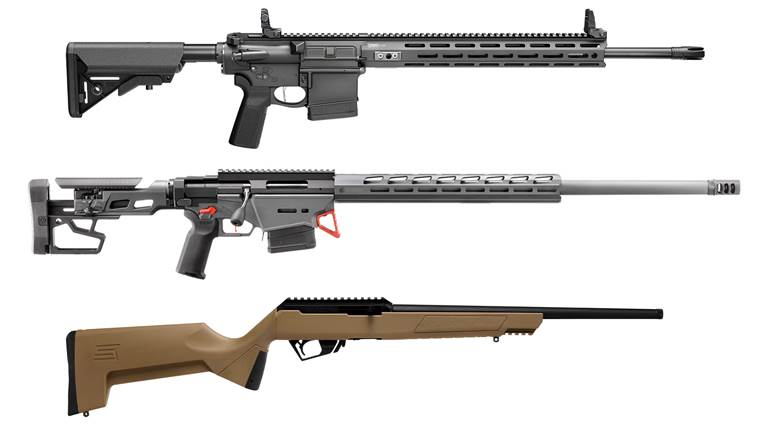
While the Kalashnikov-pattern rifle was the standard bearer of the Cold War-era Soviet Union, the Vz.58 was an intriguing satellite-state variant adopted by the Czechoslovakian Army in 1958. Externally similar to the standard AK-pattern rifle but internally quite different, the Vz. 58 represented the well-established Czech arms-making community’s independent streak. A semi-automatic-only variant is now offered by CZ-USA as the VZ 58 Military Sporter.
Inspired by the German StG44, its prototypes were chambered for the 7.92x33 mm cartridge. As a result, the VZ 58 is mechanically distinct from the Kalashnikovs with no parts interchangeability. Even so, the Czechs ultimately chambered the rifle in the Soviet-standard 7.62x39 mm cartridge.
The svelte VZ 58 Military Sporter features a milled receiver rather than a stamped one, yet the gun weighs roughly 1 lb. less than a comparable Kalashnikov. Rather than employing a heavy bolt carrier with a fixed gas piston rod, the gas-operated VZ 58 features a short-stroke piston system with a separate piston rod located above the barrel that can be easily removed without having to disassemble the rifle. The 16-inch barrel features a welded-on extension to its threaded muzzle that brings the rifle’s overall length to 36 inches.
Instead of a rotating bolt, the VZ 58 employs a tilting lock system. When gas is bled through the gas port in the barrel during firing, the short-stroke gas piston is driven back a short distance to give a tap to the bolt carrier and move it rearward. After a short distance of free travel to allow chamber pressure to drop to safe levels, the bolt carrier causes the rifle’s tilting locking piece to unlock from recesses in the receiver, allowing the bolt to move rearward. Even the nature of the VZ 58’s firing mechanism is unique. Rather than a conventional hammer-actuated firing pin, the Czech rifle features a striker-fired mechanism in which the trigger activates the disconnector, which in turn lowers the sear and releases the spring-loaded striker to impact the base of the firing pin.
The VZ 58’s 30-round, detachable box magazine is of light alloy rather than steel, bringing its weight down to roughly half of that of a steel Kalashnikov magazine. The sights consist of a wing-protected front post and open notch rear sight. There is no scope rail or mount on the receiver of the VZ 58.
From an operator’s standpoint, the VZ 58 is quite similar to the Kalashnikov; but it does have some interesting differences. To load, rock in the alloy magazine from front to back as with a Kalashnikov. To charge, retract the bolt carrier and release it by pulling back the operating handle on the top right of the bolt carrier. The VZ 58’s small rotating paddle-type safety lever is on the lower right side of the milled receiver, just above the pistol grip. Magazines are released by pushing forward on the release lever just forward of the trigger guard.
The follower of an empty magazine engages a bolt stop, which is located forward of the trigger guard and to the right of the magazine release lever. The bolt stop can also be engaged manually.
The VZ 58 combines original Czech Vz.58 parts with a new semi-automatic-only receiver and five U.S.-made parts. The latter include the steel sear, disconnector and trigger, and plastic magazine follower and floorplate.
The VZ 58 Military Sporter is an impressive semi-automatic rendition of the original military rifle. The fit is excellent and the finish is evenly applied to the cleanly machined parts. The stock of the Military Sporter is particularly interesting in that it is a wood-impregnated plastic.
Handling of the small and svelte rifle was also quite good, with it shouldering and swinging quickly and easily. During testing, the rifle fired several hundred rounds of ammunition without a single malfunction. Due to its light weight, recoil was noticeable but by no means unpleasant. Cases were ejected upward through the large ejection port. The cases sometimes landed on top of the receiver or on top of the shooter’s head. Accuracy was quite reasonable considering the necessity of using the iron sights.
For those with an interest in Cold War-era firearm design or collectors just looking for a unique variant of the 7.62x39 mm semi-automatic rifle, the CZ-USA VZ 58 Military Sporter offers a high-quality rendition of one of the lesser-known rifles of that era.



































